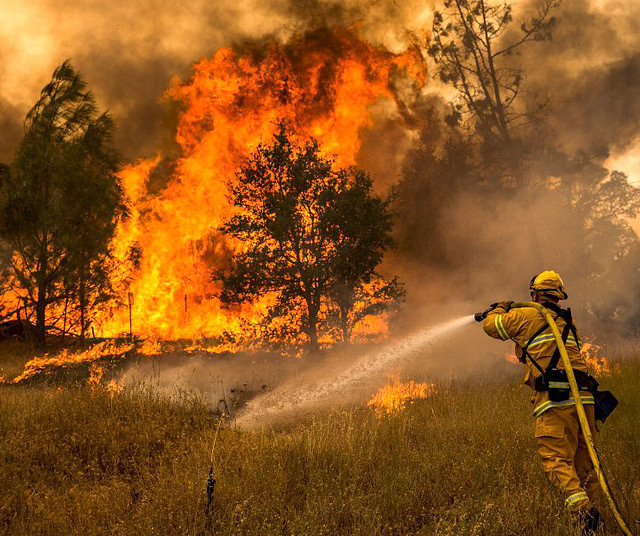
August 26, 2018
This year’s fires in California have been overwhelming.
It seems that nobody in the state has been left untouched.
In early July, one of our activist members who lives in Goleta, north of Santa Barbara, sent photos of her fire-damaged neighborhood. Her house remained along a street where other homes had been turned into piles of ashes by a fire that swept through during a heat wave. Temperatures reached triple digits in an area where 80 degrees is considered hot.

She wrote that she was in shock and grieving and had not slept much in three days. Scientists were speculating that the freaky hot weather in the region was an example of the effects of climate change.
Since that July Goleta fire, others have burst out all over the state, but particularly along the North Coast, creating what are now considered the largest, most devastating fires in modern California history.
The fires have drawn attention worldwide, and have offered opportunities for everyone from state legislators to federal cabinet secretaries, to opine about causes and solutions.
One result is a passel of misinformation broadly disbursed.
The fires have provided an opportunity for one particular federal cabinet secretary to spew insults and search for scapegoats at a time when a more informed leader would try to bring people together and offer assistance.
Last year was a terrible fire year. This year is a terrible fire year. Everyone who follows this issue believes that next year will likely be a terrible fire year. It is, as our governor says, the new normal.
Scientists have been predicting for years that extreme temperatures and more fires would be among the results of climate disruption. The future has arrived and we are experiencing exactly what those scientists predicted.
So what should policymakers do now to address these issues in a productive way?
First, listen to this wakeup call to prepare for the impacts of climate change. It’s time to accelerate the planning and spend the time and money needed to make sure we don’t put people and property in the way of fires, floods and sea-level rise. What’s typically referred to as adaptation is something the next governor will have to make a priority, even as the state continues leading on ways to reduce our climate emissions.
Second, work from the home outward on fire prevention. This starts with local and state policies that discourage building on the edge of fire-prone wildlands. It continues with making sure regulations and incentives and public outreach is in places to make sure homes and buildings all over the state—not just on the wildlands edge—are built and retrofit to be as fire resistant as possible.
Third, start analyzing and talking about wildfires in specifics, not in sweeping generalities. It’s easy for policymakers to overlook the important differences in the natural landscapes. That can make a difference in crafting policies to reduce fire potential. For instance, the most devastating fires have occurred in coastal or slightly inland areas far from forests. Appropriate management of wildlands dominated by chaparral is different from appropriate management of forests.
Fourth, invest in forest management that emphasizes natural processes. Where fires have been located in forests, they have been fed in part by dense growth that is the result of nearly 100 years of fire suppression. Prescribed fire needs to be used more and better during the cooler season to help restore natural health to forests. Managing forests, by the way, does not necessarily mean inviting wholesale logging onto public lands, as one federal official is suggesting.
Fifth, when and where beetle-killed trees must be removed to protect homes and communities, encourage alternatives to biomass incineration for dealing with those trees. State leaders have allowed the conventional biomass incineration industry—a highly polluting and expensive industry—to play too large a role in determining how to use beetle-killed trees.
It has been and will continue to be necessary in the short term to remove dead trees that are in neighborhoods and mountain communities. More than 1.2 million trees so far have been removed for safety reasons. Now the question becomes, what can we do with those trees that will provide jobs without feeding biomass incinerators? The most obvious answer is to produce things that people want—furniture, flooring, paneling, plywood, mulch, soil amendment, animal bedding.
Climate change is presenting us with a lot of new challenges. If we resist the urge to devolve into name-calling as one national leader has, then we can find ways to protect the environment, the economy and people like our activist in Goleta.
Sincerely,

Kathryn Phillips
Director
Sierra Club California is the Sacramento-based legislative and regulatory advocacy arm of the 13 California chapters of the Sierra Club.
Please consider making a monthly donation.